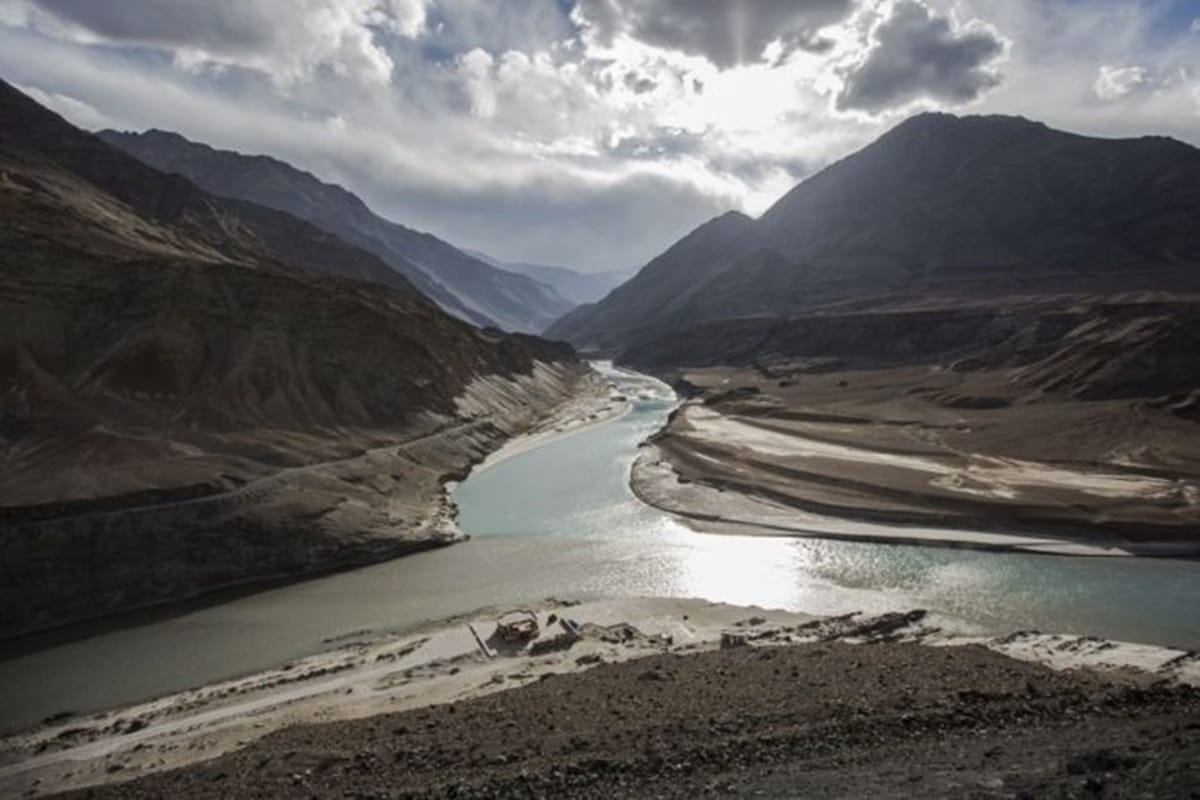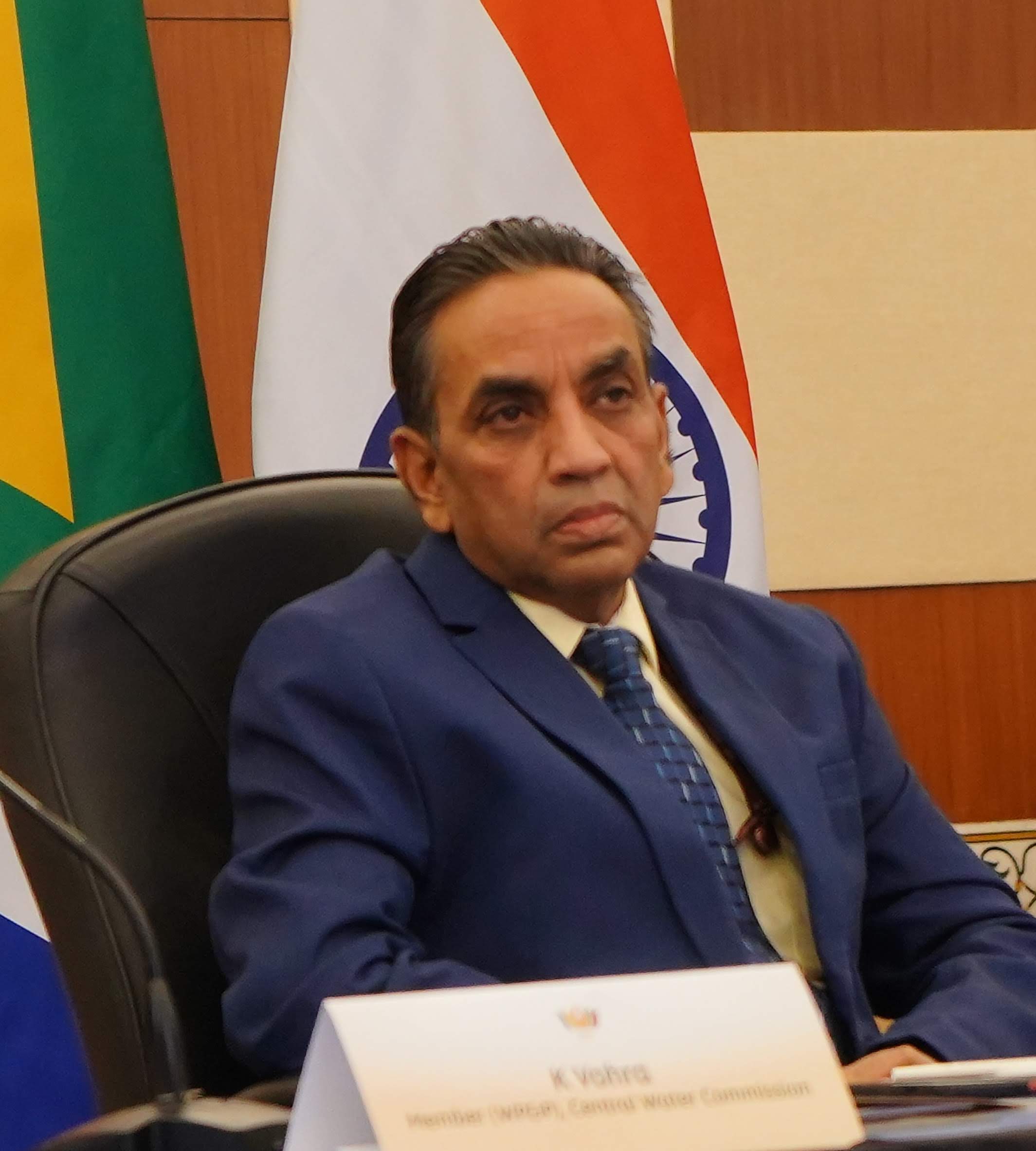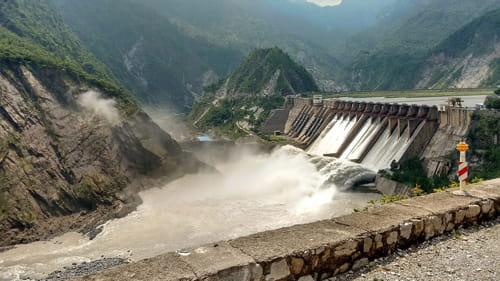
The point where the River Indus meets the Zanskar River at Sangam near Leh in Ladakh, India | Daniel Berehulak/Getty Images

India cannot accept Pakistan's selective and convenient interpretations of the Treaty, which seek to impose restrictions beyond its already limiting provisions. Like India, Pakistan must acknowledge that neither can increase the quantity of available water. The path forward lies in mutual understanding and appreciation of each other's concerns, rather than confrontation and obstruction.
Introduction
The world is home to approximately 263 transboundary lakes and rivers, which cover half the globe and impact around 40% of the global population. According to the United Nations, 145 nations contain territory within international river basins, and 30 countries lie entirely within these shared water systems.1 As a result, water disputes are a common global phenomenon.
India too shares several major transboundary rivers, including the Ganga, Indus, Sutlej, Ravi, Kosi, Ghagra, Manas and Brahmaputra. However, India has an impressive history of resolving water disputes through international agreements and treaties, such as the Indus Waters Treaty, Mahakali Treaty and Ganges Treaty. Seen as one of the most successful international treaties, the Indus Waters Treaty had been described by the former U.S. President Dwight Eisenhower as "one bright spot ... in a very depressing world picture that we see so often.”2
The Indus Waters Treaty
The Indus Waters Treaty, negotiated over eight long years, is outlined in its preamble. It focuseson achieving the most complete and satisfactory utilization of the Indus river system's waters, in a spirit of goodwill and friendship. It was in this spirit that India accepted only 18% of the Indus waters (the Ravi, Beas and the Sutlej) in spite of the fact that 69% of the flow is from its own catchments. India also contributed £62.06 million (around $4 billion today) towards replacement works in Pakistan to facilitate this lopsided water distribution.3 In return, India secured restricted rights to use the Western Rivers (the Indus, Jhelum and the Chenab), subject to numerous limitations made to address Pakistan's concerns and achieve lasting regional peace. As Prime Minister Nehru stated in Parliament, "…we purchased a settlement, if you like; we purchased peace to that extent and it is good for both countries."4 As time would tell, this hope for the spiritof the preamble was unfound.
Following the ratification of the Indus Waters Treaty, India's measured approach to development on the Western rivers inadvertently fostered a misconception in Pakistan that they held exclusive rights to these waters. India's attempts at fostering amicable relations have often resulted in concessions that have not always served its best interests. A prime example is the 1978 agreement regarding the Salal Hydroelectric Project. Pakistan's persistent objections led to India acquiescing to design modifications, which ultimately compromised the dam's operational flexibility. Similarly, India's decision to suspend work on the Tulbul Navigation Project, in hopes of improving bilateral relations, has rendered the project largely obsolete.

View of Salal Dam from Jyotipuram-Salal road
The efficacy of transboundary water-sharing agreements heavily relies on the upper riparian state's responsible conduct. In this context, the Indus Waters Treaty has endured through three wars and numerous bilateral tensions, primarily due to India's generous stance and willingness to accommodate Pakistan's concerns.
However, this approach has not always yielded the desired reciprocity or fostered the level of cooperation originally envisioned. This situation underscores the complex dynamics of water diplomacy and the challenges in balancing national interests with international cooperation. It also highlights the need for a more balanced approach that ensures fair utilization of shared water resources while maintaining regional stability.
Recognising Hydropower
India’s policymakers gradually recognized the imperative for a rapidly growing economy like ours to meet its development needs by leveraging the hydropower potential available to her under the Treaty. Consequently, India accelerated the planning and execution of several hydropower projects, including Baglihar (900 MW), Kishanganga (330 MW), Ratle (850 MW), Sawalkote (1856 MW), Kirthai-I (390 MW), Kirthai-II (930 MW), Dulhasti-II (260 MW), Pakal Dul (1000 MW), Kiru (624 MW), Kwar (540 MW), and Sach Khas (288 MW).
Pakistan understands that the underdevelopment of Kashmir is crucial to fuel dissent in the region. Frustrated by India's rapid development in the Indus basin, Pakistan strategically began using the Treaty as a political tool to impede progress on our side, which aims to benefit the people of Kashmir.
To garner international support, Pakistan portrays itself as a victim and casts India as an aggressor, alleging that India is stealing its waters and waging a water war against a "helpless nation." This narrative, amplified by the ill-informed and skewed views of the international community, echoes that both countries might face war over Indus waters if issues are not resolved amicably. However, this is far from the truth. The reality is that Pakistan has failed to harness its own abundant resources and uses this issue to divert attention of its population from its systemic failures.
The Real Challenges of Pakistan
(a) Elevated Population Growth Rate
India, with a population of 450 million in 1960, increased to 1417 million by the year 2022. Throughout this timeframe, the country's population growth rate fluctuated around 2.30% till the eighties and then steadily declined to 0.68% by 2022. In contrast, Pakistan's population, starting at 45.9 million in 1960, experienced a more rapid growth trajectory, reaching 245 million by 2022. Its population growth rate, which stood at 2.48% in 1960, continued to increase until 1980, reaching 4.52%, after which it began a gradual decline to 1.91% by 2022.5
Consequently, India's population expanded by 314% over the period, whereas Pakistan's population surged by 533%. This rapid population growth, combined with inadequate water management practices, has resulted in a significantdecrease in the per capita availability of water. As a consequence, Pakistan, presently, has been ranked third among the most water-scarce nations by the International Monetary Fund (IMF), with concerns over its potential transition to an absolute water-scarce country by 2025.6
(b) Inefficient Water Management
Water scarcity in Pakistan stems primarily from inefficient distribution and mismanagement. The agriculture sector, while contributing only 18% to the country's Gross Domestic Product (GDP), consumes a staggering 97% of theIndus River's freshwater. This disproportionate usage is exacerbated by the cultivation of water-intensive crops such as rice, wheat, sugarcane, and cotton, reflecting poor crop selection strategies.7
The Indus River system receives an average annual inflow of approximately 145 Million Acre Feet (MAF). Of this, 101 MAF is allocated to agriculture, 14 MAF to municipal and industrial use, and 30 MAF flows unutilized into the sea. Alarmingly, only 65 MAF of the water diverted for agriculture reaches the fields, with 36 MAF lost due to system inefficiencies. The total water wasted, including the unutilized flow to the sea, amounts to 66 MAF – twice India's share in the Indus Waters Treaty.8
(c) Depleting Ground Water
Groundwater depletion further compounds Pakistan's water crisis. Despite possessing the world's fourth-largest groundwater aquifer, larger than England, being the third-largest groundwater user globally with 1.2 million tube wells, Pakistan faces severe depletion issues. The Leadership for Environment and Development (LEAD) reports a continuous decline in groundwater tables across many areas of the Indus basin, indicating a critical imbalance between abstraction and recharge.
Excessive aquifer mining in freshwater areas has led to falling water tables, while saline waters predominate in central Doab areas. The Cholistan area in southern Punjab is notorious for its highly brackish water, unsuitable for drinking. Some regions in Punjab have reported high fluoride and arsenic concentrations in groundwater. The use of poor-quality groundwater for irrigation has resulted in widespread salinization of agricultural lands in the Indus basin, further compromising water quality and soil health.9
(d) Lack of Storage
Pakistan's water storage capacity has stagnated since the construction of the Mangla (1967) and Tarbela (1976) dams. These two reservoirs have a combined live storage capacity of 14.399 million acre-feet (MAF), which represents only 10% of Pakistan's annual share of Indus waters. In contrast, India has built major dams on each of its Eastern rivers: Ranjit Sagar on the Ravi, Bhakra on the Sutlej, and Pong on the Beas. These Indian dams collectively store 13.41 MAF, accounting for 41% of India's share of Indus waters—a figure that aligns with the global average.
The disparity in waterinfrastructure is stark: Pakistan has approximately 164 dams, while India boasts 6,281.10 This limited storage capacity in Pakistan results in over 30 MAF of water flowing unused into the Arabian Sea below Kotri Barrage annually. The combination of insufficient storage and changing climate patterns has led to severe water shortages in Pakistan as well as floods during monsoon.
(e) Inter provincial disputes:
In 1991, the Water Apportionment Accord (WAA 1991) was signed by Punjab, Sindh, Khyber Pakhtunkhwa, and Balochistan to resolve long-standing water distribution conflicts. However, ambiguities in the accord's language and conflicting interpretations by each province have undermined its effectiveness. Punjab argues that the new distribution percentages apply only to additional water resources, while Sindh maintains that they should be applied to the entire water quantity.
This disagreement has fuelled decades of tension between Punjab and Sindh over Indus River waters allocation. Balochistan has also accused Sindh of misappropriating its water share. The resulting mistrust has stalled crucial projects, such as the Kalabagh Dam—proposed in the 1980s to significantly increasewater storage—which remains unbuilt while water continues to flow unused to the sea. Other infrastructure projects, including the Chashma-Jhelum Link Canal and Thal Canal, have also been mired in controversy, further hampering Pakistan's ability to effectively manage its water resources.
Water Scarcity in Pakistan
Water scarcity has become a critical issue in Pakistan, threatening the country's ability to provide adequate water access to its growing population in the coming years without significant policy changes. To address this challenge, Pakistan must invest in infrastructure such as dams, reservoirs, canals, and irrigation systems to enhance water storage capacity and improve water use efficiency.
Additionally, the country should promote water conservation through micro-irrigation techniques, implement sustainable groundwater management practices, and shift towards less water-intensive crops. Crucially, Pakistan needs to adopt a pragmatic approach to resolving water-related disputes with India through dialogue, negotiation, and cooperation, while respecting India's rights. This approach would be more productive than creating political rhetoric against India to divert attention from domestic issues.
Pakistan and India’s Water Strategy
Unfortunately, instead of a vehicle of progress, Pakistan has become a vehicle of protest. Its India-centric approach, prioritizing perceived Indian losses over its own gains, has become counterproductive. This obsession has led Pakistan to object to nearly all of India's hydroelectric projects on the Western Rivers, regardless of their size or design, often using these objections to propagate a narrative of India infringing on Pakistan's rights. Paradoxically, Pakistan has opposed projects like Pakal Dul and Tulbul despite acknowledging their potential benefits in terms of regulated water flow. This approach has resulted in delays, such as the stay on the Kishangangaproject through the Court of Arbitration, which appears to be Pakistan's primary objective in all Indian development projects. Consequently, Pakistan has neglected its own crucial infrastructure projects, such as the long-delayed Kalabagh Dam, and allowed its existing water infrastructure to deteriorate.
India, for its part, recognizes both its obligations and rights under the Indus Waters Treaty regarding hydroelectric projects on the Western Rivers. The country remains committed to upholding the integrity of the Treaty and has consistently honoured Pakistan's water entitlements, even during periods of war and strained relations.
However, India cannot accept Pakistan's selective and convenient interpretations of the Treaty, which seek to impose restrictions beyond its already limiting provisions. Like India, Pakistan must acknowledge that neither can increase the quantity of available water. The path forward lies in mutual understanding and appreciation of each other's concerns, rather than confrontation and obstruction.
(Exclusive to NatStrat)
Endnotes: